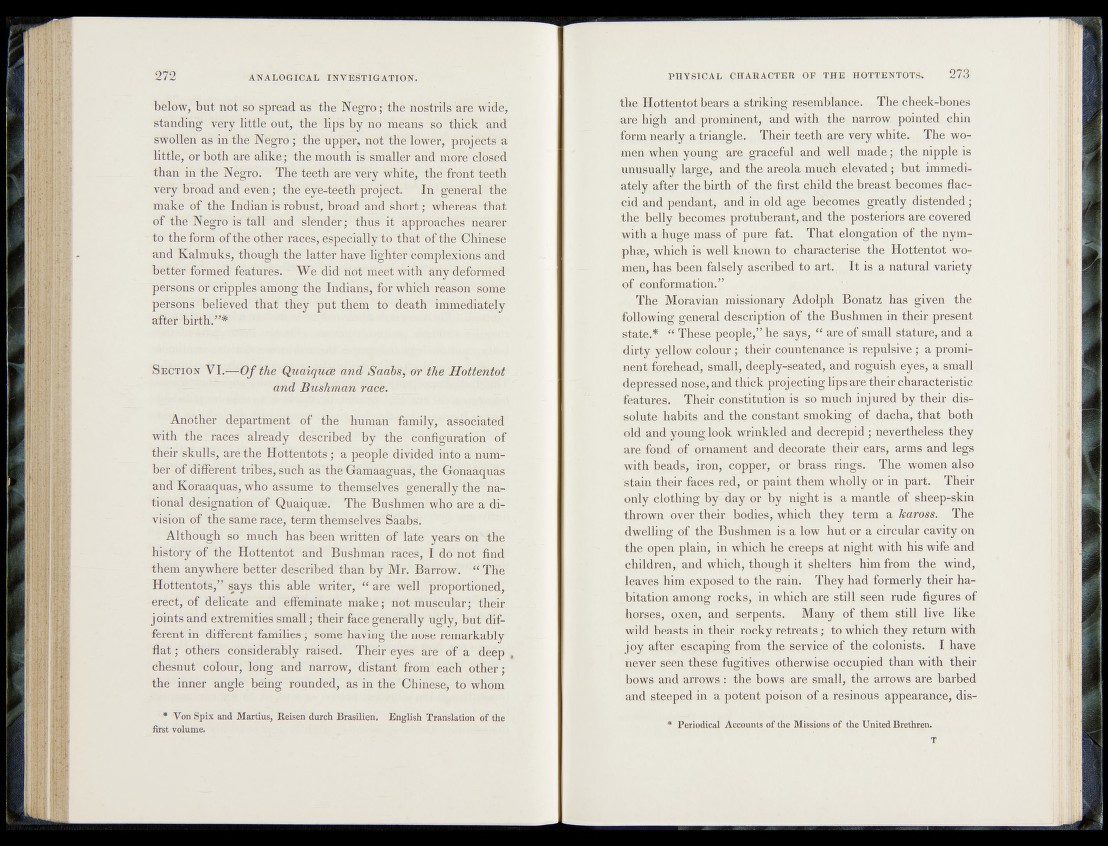
below, but. not so spread as the Negro'; the nostrils are wide,
standing* very little out, the hpTs by h^inèaris sb 'thick and
swollen as in the Npgr#|’ the upperf riot theifowèr, projects a
little, or both !are alike; the moüth is -smaller and móretclosed
than in "the Negfb* The teeth are very white, the front teeth
very broad and even; thecj/’Mteeth project:1 In general the1
make of the Indian is robust, broad and short; whereas that
of the Negro is tall and slender; thus it approaches nearer
to the form of the other races, especially to that of the Chinese
and Kalmuks, though the latter have lighter complexions and
better formed features. "W e did not meet with any deformed
persons or cripples among the Indians, for which reason some
persons believed that they put them to ■ death immediately
after birth.
Section V I.— O f the Quaiquce and Saabs, o't the Hottentot
and Bushman race.
Another department of the human' family,' associated
with the ^ races already described by the Configuration of
their skulls, are the Hottentots; a people divided into a number
of different tribes, such as the Gamaaguas, the Gonaaqu'asJ
and Koraaquas, who assume to themselves generally the national
designation of Quaiquae. The Bushmen who are a division
of the same race, term themselves Saabs.
Although so much has been written of late years onMhe
history of the Hottentot and Bushman races, I db not find
them anywhere better described than by Mr. Barrow. “ The
Hottentots,” says this able writer, “ arc well proportioned,
erect, of delicate and effeminate make; not muscular; their
joints and extremities small; their face generally ugly, but different
in different families; some having the nose remarkably
flat; others considerably raised. Their eyes are of a deep
chesnut colour, long and narrow, distant from each other;
the inner angle being rounded, as in the Chinese* to whom
* Von Spix and Martins, Reisen durch Brasilien, English Translation of the
first volume.
the Hottentqfel^ars a striking resemblance. The cheek-bones
are high and prominent, and witb^the narrow, pointed, chin
form nearly a triangle. Their teeth, are very w hite.:;(The women
whgn young are ^gr^ce^ul an^^telb made; the pipple is
unusually ?l|trg£ and thefaj.eola much glevated; but-immediately
.after the birth of. the.fifit .ghild the breast,beppmj^ ,flac-
cid and pendant, and.in,ol,d,age/tbecomes greatly distended;
the belly t becomes protuberant, and Vhc pp^teriors are covered
with a huge ,ma§s of pure fat. That edopgation of the nym-
phse, which is well known to characterise the Hottentot women,
has been falsely ascribed to art.p It^;i^ a natural variety
of conformation. ”
The Moravian' missionary Adolph Bonatz has given the.
following general description of the Busijnienin their present
state.* “ Th'eiae-people,” he; says, “ are of-small >||ature, and a
dirty yellow c'f lourth eir countenance is repulsive/^ a prominent
forehead, small, deeply-seated, .apdycpuish eyes^a'small
depressed nose, and thick proj ecting lips are their characteristic,
features. Their constitution is;so much injured by.their dissolute
habits and the constant smoking of dacha,, that both
old and young look wrinkled and decrepid ; nevertheless they
are., fond of ornament and decorate their ears, arms and legs
with beads, iron, copper, or brass rings. The women also
stain their faces red,Jtor paint them wholly or in part. .Their
only clothing by-day or by night is a mantle of sheep-skip
thrown over their* bodies, which., they term a Jcaross. The
dwelling of the Bushmen is a low hut or a circular cavity on
the open plain, in which he creeps at night with his wife and
children, and which, though it shelters him from the wind,
leaves him exposed to the rain. They had formerly their habitation
among rocks, in which are still seen rude figures of
horses, oxen, and serpents. Many of them still live like
wild beasts in their rocky retreats; to which they return with
joy after escaping from the service of the colonists., I have
never seen these fugitives otherwise occupied than with their
bows and arrows : the bows are small, the arrows are barbed
and steeped in a potent poison of a resinous appearance, dis-
* Periodical Accounts of the Missions of the United Brethren.